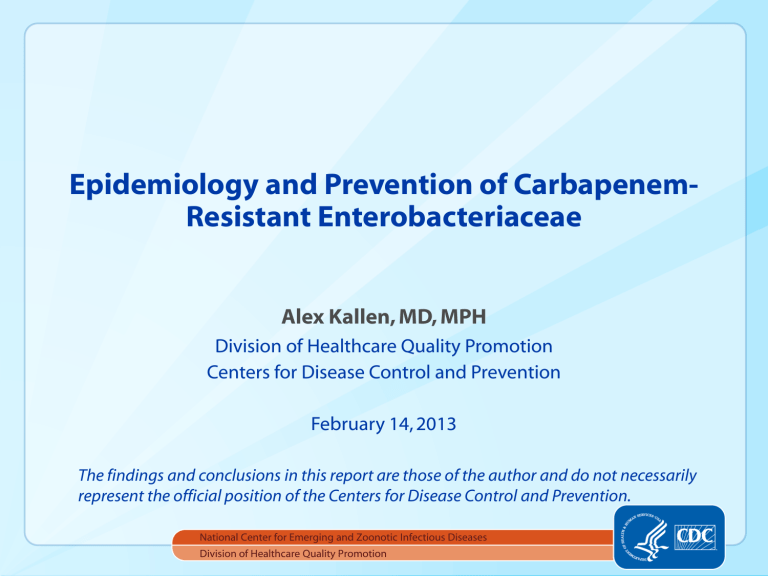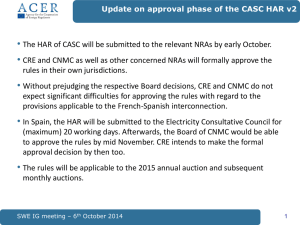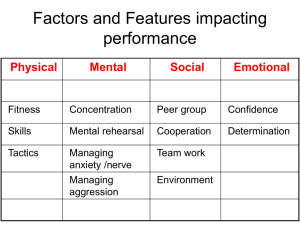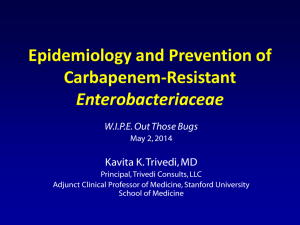CRE - Dr. Kallen from the CDC

Epidemiology and Prevention of Carbapenem-
Resistant Enterobacteriaceae
Alex Kallen, MD, MPH
Division of Healthcare Quality Promotion
Centers for Disease Control and Prevention
February 14, 2013
The findings and conclusions in this report are those of the author and do not necessarily represent the official position of the Centers for Disease Control and Prevention.
National Center for Emerging and Zoonotic Infectious Diseases
Division of Healthcare Quality Promotion
Objectives
Describe the epidemiology of carbapenem-resistant
Enterobacteriaceae (CRE) in the United States
Review measures necessary to halt transmission
Recognize the importance of a regional approach to
CRE control
Enterobacteriaceae
Normal human gut flora & environmental organisms
More than 70 species
Range of human infections: UTI, wound infections, pneumonia, bacteremia
Important cause of healthcare- and communityassociated infections
Some of the most common organisms encountered in clinical laboratories
Pathogens Reported to NHSN
2009-2010
Overall CLABSI CAUTI VAP SSI percentage
E. coli
(rank)
These three groups of organisms make up about
25% of organisms reported to NHSN Device and
8% 11% 10% 4%
P. aeruginosa 8% (5) 4% 11% 17% 6%
Enterobacter spp.
5% (8) 5% 4%
Sievert D, et al. Infect Control Hosp Epidemiol 2013; 34: 1-14
9% 4%
Enterobacteriaceae
Resistance to β-lactams has been a concern for decades
β-lactamases
Extended-spectrum β-lactamases
Carbapenems
Mechanisms of Carbapenem-Resistance in
Enterobacteriaceae (CRE)
Before 2000: Extended – spectrum cephalosporinase + porin loss
Extended-spectrum β-lactamases (ESBLs)
AmpC-type enzymes
1986-1990 in NNIS 2.3% of Enterobacter NS to imipenem.
Did not increase over the time period unlike imipenem
NS Pseudomonas Carbapenemase production
Gaynes and Culver. ICHE 1992 13:10-14
• Isolate collected in 1996 during an ICU surveillance project from NC
• Class A β-lactamase
Carbapenemase-producing CRE in the United
States
DC
AK
HI
PR
Patel, Rasheed, Kitchel. 2009. Clin Micro News
CDC, unpublished data
Nov, 2006
KPC-producing CRE in the United States
DC
HI
PR
AK
Patel, Rasheed, Kitchel. 2009. Clin Micro News
MMWR MMWR Morb Mortal Wkly Rep. 2010 Jun 25;59(24):750.
MMWR Morb Mortal Wkly Rep. 2010 Sep 24;59(37):1212.
CDC, unpublished data
Worldwide Distribution of KPC
Walsh. 2010. International Journal of Antimicrobial Agents
Enzyme
KPC
NDM-1
IMP
VIM
Classification
Class A
Carbapenemases
Activity
Hydrolyzes all β-lactam agents
Class B: metalloβlactamse (MBL)
Hydrolyzes all β-lactam agents except aztreonam
OXA Class D
Hydrolyzes carbapenems but not active against 3 rd generation cephalosporins
KPC
NDM-1
IMP
VIM
Enzyme
OXA
Carbapenemases
Classification Number identified to date in US
Activity
Class A
Hydrolyzes all β-lactam agents
29 (10 states)
3 (1 state) Class B: metalloβlactamse (MBL)
Hydrolyzes all β-lactam agents except aztreonam
3 (2 states)
3 (2 states) Class D
Hydrolyzes carbapenems but not active against 3 rd generation cephalosporins
Carbapenemase-producing CRE in the United
States
HI
PR
AK
Patel, Rasheed, Kitchel. 2009. Clin Micro News
MMWR MMWR Morb Mortal Wkly Rep. 2010 Jun 25;59(24):750.
MMWR Morb Mortal Wkly Rep. 2010 Sep 24;59(37):1212.
CDC, unpublished data
DC
KPC
KPC, NDM
KPC, NDM,
OXA
KPC, NDM,
VIM
KPC, NDM,
VIM, IMP
Change in CRE incidence, 2001-2011
Organism
Klebsiella pneumoniae and oxytoca
E. coli 1,424
Enterobacter aerogenes and cloacae
Total
553
2,631
National Nosocomial infection
Surveillance system, Number (%) of isolates
2001
Isolates Tested
654 253
(38.7)
Nonsusceptible
4 (1.6)
National Healthcare Safety
Network, Number (%) of isolates
2011
Isolates Tested
1,902 1,312
(70.0)
Nonsusceptible
136 (10.4)
421
(29.6)
288
(52.1)
962
(36.6)
4 (1.0)
4 (1.4)
12 (1.2)
3,626 2,348
(64.8)
24 (1.0)
1,045 728 (69.7) 26 (3.6)
6,573 4,388
(66.8)
186 (4.2)
Change in CRE incidence, 2001-2011
Organism
Klebsiella pneumoniae and oxytoca
E. coli 1,424
Enterobacter aerogenes and cloacae
Total
553
2,631
National Nosocomial infection
Surveillance system, Number (%) of isolates
2001
Isolates Tested
654 253
(38.7)
Nonsusceptible
4 (1.6)
National Healthcare Safety
Network, Number (%) of isolates
2011
Isolates Tested
1,902 1,312
(70.0)
Nonsusceptible
136 (10.4)
421
(29.6)
288
(52.1)
962
(36.6)
4 (1.0)
4 (1.4)
12 (1.2)
3,626 2,348
(64.8)
24 (1.0)
1,045 728 (69.7) 26 (3.6)
6,573 4,388
(66.8)
186 (4.2)
Change in CRE incidence, 2001-2011
Organism
Klebsiella pneumoniae and oxytoca
E. coli 1,424
Enterobacter aerogenes and cloacae
Total
553
2,631
National Nosocomial infection
Surveillance system, Number (%) of isolates
2001
Isolates Tested
654 253
(38.7)
Nonsusceptible
4 (1.6)
National Healthcare Safety
Network, Number (%) of isolates
2011
Isolates Tested
1,902 1,312
(70.0)
Nonsusceptible
136 (10.4)
421
(29.6)
288
(52.1)
962
(36.6)
4 (1.0)
4 (1.4)
12 (1.2)
3,626 2,348
(64.8)
24 (1.0)
1,045 728 (69.7) 26 (3.6)
6,573 4,388
(66.8)
186 (4.2)
EMERGING INFECTIONS PROGRAMS
MUlti-site Gram-negative Surveillance
Initiative (MuGSI)
Active CRE surveillance
MuGSI (Multi-site Gram-Negative Surveillance
Initiative) project
Active, laboratory-initiated, population-based surveillance for CRE and CR Acinetobacte r (CRAB) in 6 US sites (sterile sites and urine)
Pilot 8/11 to 12/11(3 sites)
• 72 CRE (64 patients) - most (59) from one site (OR had 3)
• Urine most common source (89%)
• CR K. pneumoniae most common (68%)
• Most with onset outside hospital ( 66%) o o
41/47 (87%) had healthcare exposures (72% hospitalization)
6 were community onset without healthcare exposures
Kallen et al. ID Week 2012, San Diego
ROLE OF LONG-TERM CARE
KPC outbreak in Chicago, 2008
• Of 40 KPC patients, only 4 definitively acquired KPC in acute care hospital
• Most (60%) linked to 1 LTACH
Won et al. Clin Infect Dis 2011; 53:532-540
KPC Point Prevalence Survey - Chicago
Hospitals with >10 ICUs and 7 LTACHs
Two point prevalence surveys (2010 and 2011)
Results
All LTACHs and 15/24 hospitals had at least one patient with KPC
In acute care 3.3% of patients colonized (30/909)
In LTACH – 30.4% of patients colonized (119/391)
Lin M et al. ID Week 2012 San Diego #396
CRE Prevalence in LTCF: By Type
Prevalence of CRE Carriage at admission to 4 acute care hospitals
33.3%
27.3%
8.3%
1.5%
0% from those admitted to the community
Prabaker K et al. ICHE 2012; 33:1193-1199
Why are CRE Clinically and Epidemiologically
Important?
Why are CRE Clinically and Epidemiologically
Important?
Cause infections associated with high mortality rates
Risk Factors for and Outcomes of Carbapenem-
Resistant
K. pneumoniae
(CRKP) Infections
Case control study done in NYC, where CRKP (generally
KPC producers) are now common
99 patients with invasive CRKP infections (mostly bloodstream) compared to 99 patients with invasive carbapenem susceptible K. pneumoniae infections.
Patel et al. Infect Control Hosp Epidemiol 2008;29:1099-1106
Mortality
60
50
40 p<0.001
p<0.001
30
20
10
48 20 38 12
0
Overall Mortality Attributable
Mortality
OR 3.71 (1.97-7.01) OR 4.5 (2.16-9.35)
Patel et al. Infect Control Hosp Epidemiol 2008;29:1099-1106
CRKP
CSKP
Why are CRE Clinically and Epidemiologically
Important?
Cause infections associated with high mortality rates
Resistance is highly transmissible
Between organisms – plasmids
Between patients
Why are CRE Clinically and Epidemiologically
Important?
Cause infections associated with high mortality rates
Resistance is highly transmissible
Between organisms – plasmids
Between patients
Treatment options are limited
Pan-resistant strains identified
Could be decades before new agents are available to treat
Pan-Resistant Enterobacteriaceae
Report from New York
City of 2 “Panresistant”
K. pneumoniae
1 patient died
1 had continuing asymptomatic bacteruria
Elemam A, et al. Clin Infect Dis 2009; 49:271-4
Why are CRE Clinically and Epidemiologically
Important?
Cause infections associated with high mortality rates
Resistance is highly transmissible
Between organisms – plasmids
Between patients
Treatment options are limited
Pan-resistant strains identified
Could be decades before new agents are available to treat
Potential for spread into the community
E. coli common cause of community infection
MDR GNRs in the Community
ESBLs
40 patients with CTX-M E. coli from urine in a facility in Texas
• 30/40 were isolated from outpatients, 7 (18%) had no documented contact with the healthcare system in previous 6 months and no comorbidities
Swedish travelers – 100 travelers outside of Northern Europe
• 24 came back with ESBL in stool (mostly NDM)
• 7/8 to India, 10/31 to Asia
• Development of gastroenteritis a risk factor
• 5/21 persistently colonized
Lewis JS, et al. Poster Presentation, 49 th ICAAC 2009, San Francisco
Tangden T et al. AAC 2010: 3564-3568
MDR GNRs in the Community
NDM
Identified in K. pneumoniae in river in Hanoi, Viet Nam
Cause of community-onset infections in India
• In one survey, isolates from 2 sites often from community acquired
UTIs
Gene for NDM detected in 2/50 drinking water samples and
51/171 water seepage samples from New Delhi
Isozumi R et al. EID 2012: 1383-4
Kumarasamy K Lancet ID 2010;
Walsh TR Lancet ID 2011:355-362
Why are CRE Clinically and Epidemiologically
Important?
Cause infections associated with high mortality rates
Resistance is highly transmissible
Between organisms – plasmids
Between patients
Treatment options are limited
Pan-resistant strains identified
Could be decades before new agents are available to treat
Potential for spread into the community
E. coli common cause of community infection
In most areas in the United States this organism appears to infrequently identified
Facility characteristic
All acute care hospitals
Short-stay acute hospital
Long-term acute care hospital
Number of facilities with CRE from a
CAUTI or CLABSI
(2012)
181
145
36
Total facilities performing
CAUTI or
CLABSI surveillance
(2012)
3,918
3,716
202
Hospital bed size
<100
100-299
300-499
≥500
Region
Northeast
Midwest
South
West
48
46
41
45
63
30
50
29
1,609
1,480
541
258
658
927
1,503
804
(%)
(4.6)
(3.9)
(17.8)
(3.0)
(3.1)
(7.6)
(17.4)
(9.4)
(3.0)
(3.2)
(3.6)
Facility characteristic
All acute care hospitals
Short-stay acute hospital
Long-term acute care hospital
Number of facilities with CRE from a
CAUTI or CLABSI
(2012)
181
145
36
Total facilities performing
CAUTI or
CLABSI surveillance
(2012)
3,918
3,716
202
Hospital bed size
<100
100-299
300-499
≥500
Region
Northeast
Midwest
South
West
48
46
41
45
63
30
50
29
1,609
1,480
541
258
658
927
1,503
804
(%)
(4.6)
(3.9)
(17.8)
(3.0)
(3.1)
(7.6)
(17.4)
(9.4)
(3.0)
(3.2)
(3.6)
Facility characteristic
All acute care hospitals
Short-stay acute hospital
Long-term acute care hospital
Number of facilities with CRE from a
CAUTI or CLABSI
(2012)
181
145
36
Total facilities performing
CAUTI or
CLABSI surveillance
(2012)
3,918
3,716
202
Hospital bed size
<100
100-299
300-499
≥500
Region
Northeast
Midwest
South
West
48
46
41
45
63
30
50
29
1,609
1,480
541
258
658
927
1,503
804
(%)
(4.6)
(3.9)
(17.8)
(3.0)
(3.1)
(7.6)
(17.4)
(9.4)
(3.0)
(3.2)
(3.6)
Prevention
http://www.cdc.gov/hai/organisms/cre/cre-toolkit/
Surveillance and Definitions
Facilities/Regions should have an awareness of the prevalence of CRE in their Facility/Region
Could concentrate on Klebsiella and E. coli
CDC definition (based on 2012 CLSI definitions):
NS to one of the carbapenems (doripenem, meropenem, imipenem)
Resistant to all 3 rd generation cephalosporins tested
Some Enterobacteriaceae are intrinsically resistant to imipenem
( Morganella, Providencia, Proteus )
Problems with Identifying CRE
Breakpoints differ for some carbapenems between FDA and CLSI
Many automated systems do not have cards that identify down to CLSI breakpoints
In MuGSI, automated systems appear to “overcall” resistance compared to reference methods
No easy way right now to check for carbapenemases
MHT
PCR
Interventions
Core
Hand hygiene
Contact Precautions*
HCP education
Minimizing device use
Patient and Staff cohorting
Laboratory notification*
Antimicrobial stewardship
CRE Screening*
Supplemental
Active surveillance cultures
Chlorhexidine bathing
* Included in 2009 document
Contact Precautions
CP for patients colonized or infected with CRE
Systems in place to identify patients at readmission
Education of HCP about use and rationale behind CP
Adherence monitoring
Consideration of pre-emptive CP in patients transferred from high-risk settings
Contact Precautions in Long-Term Care
CP could be modified in these settings:
CP should be used for residents with CRE who are at higher risk for transmission
• Dependent upon HCP for their activities of daily living
• Ventilator-dependent
• Incontinent of stool
• Wounds with drainage that is difficult to control
For other residents the requirement for Contact Precautions might be relaxed
Standard Precautions should still be observed
Duration of Contact Precautions
33 LTCF patients colonized with MDR GNB followed for
1 year with serial (q 3 to 4 week rectal swabs)
Clearance of MDR GNB in 3/33 (9%)
Median duration of colonization 144 days
Case-control study of 66 patients with CRE
Compared those positive at readmission with those that were negative
O’Fallon E, et al. Clin Infect Dis 2009; 48:1375-81
Schechner V et al. ICHE 2011;32:497-503
Patient and Staff Cohorting
CRE patients in single rooms (when available)
Cohorting (even when in single rooms)
Staff cohorting
Preference for single rooms should be given to patients at highest risk for transmission such as patients with incontinence, medical devices, or wounds with uncontrolled drainage
Antimicrobial Stewardship
Programs to ensure:
Antimicrobials used for proper indications and duration
Appropriate spectrum
Link to Get Smart for Healthcare:
http://www.cdc.gov/getsmart/healthcare
Antimicrobial Stewardship and MDR GNRs
Antimicrobial stewardship program in
Surgical/Trauma ICU
Specific protocol for therapeutic antibiotics
Surgical antibiotic prophylaxis protocols
Quarterly rotation and limitation of dual antibiotic classes
Dortch et al Surgical Infections 2011; 12:15-25
Antimicrobial Stewardship and MDR GNRs
Proportion of MDR GNR pathogens decreased (37% to
9%)
Rate of infections caused by MDR GNRs decreased yearly by 0.78/ 1,000 patient days
Yearly decrease was for:
MDR Pseudomonas (-0.14/1,000 pd),
MDR Acinetobacter (-0.49/1,000 pd),
MDR Enterobacteriaceae (-0.14/ 1,000 pd)
Dortch et al Surgical Infections 2011; 12:15-25
CRE Screening
Used to identify unrecognized CRE colonization among contacts of CRE patients
Stool, rectal, peri-rectal
Link to laboratory protocol http://www.cdc.gov/ncidod/dhqp/pdf/ar/Klebsiella_or_
E.coli.pdf
Applicable to both acute and long-term care settings
Description of types
Point prevalence survey
• Rapid assessment of CRE Prevalence on particular wards/units
• Might be useful if lab review identifies one or more previously unrecognized CRE patient on a particular unit
Screening of epidemiologically linked patients
• Roommates
• Patients who shared primary HCP
Risk for Transmission
Observational study of ESBLs, facility screened roommates of ESBL positive patients for evidence of transmission
1/133 (1.5%) confirmed transmission of same strain type, median overall exposure time 4.3 days
In transmissions exposure was for 9 and 10 days
NDM outbreak in Canada
9 cases in 15 months, Index patient had care in India
Case-control study of transmission cases compared to exposed patients (roommates, ward mates, environmental contacts) that did not acquire NDM
Duration of exposure and exposure to certain antimicrobials (Pen,
FQ, macrolides, TMP/SMX, vancomycin, carbapenems) were significant risks
Exposure time was 26.5 days vs 6.7 days
Tschudin-Sutter S et al. CID 2012;55:1505-15514
Lowe C et al. ICHE 2013;34:49-55
Active Surveillance Cultures
Studies suggest that only a minority of patients colonized with CRE will have positive clinical cultures
CRKP Point prevalence study in Israel (5.4% prevalence rate); fewer than 5/16 had a positive clinical culture for CRKP.
A study of surveillance cultures at a US hospital found that they identified a third of all positive CRKP patients. Placing these patients in CP resulted in about 1400 days from unprotected exposure.
Weiner-Well et al. J Hosp Infect 2010;74:344-9 r
Calfee et al. ICHE 2008;29:966-8
Active Surveillance Cultures
One study from Israel used surveillance cultures - (ICU) admission and weekly; (non-ICU) patients with epi-links to CRE patients
Found a 4.7-fold reduction in in CRKP infection incidence
Kochar et al. used rectal surveillance cultures as part of a multifaceted intervention in an ICU
Found decrease in number of new patients per 1,000 patient days per quarter that were positive for CRKP
Ben-David et al. ICHE 2010; 31:620-6
Kochar et al. ICHE 2009; 30:447-52
Active Surveillance Cultures
Potential considerations:
Focus on patients admitted to certain high-risk settings (e.g., ICU) or specific populations (e.g., from LTCF/LTAC)
Generally done at admission but can also be done periodically during admission
Patients identified as positive on these surveillance cultures should be treated as colonized (i.e., Contact
Precautions, etc.)
Surveillance Sites
Rectal appears to be most sensitive (68% to 97%)
In one study rectal better than peri-rectal
Skin (axillae/inguinal) can also be colonized with CRE and can add to sensitivity if sampled
Data from 6 LTACH
Thurlow C et al. ICHE 2013;34:56-61
Weiner-Well Y et al. J Hosp Infect 2010; 74:344-349
Chlorhexidine Bathing
Limited evidence for CRE
• Used effectively by Munoz-Price in outbreak in LTAC as part of a package of interventions
Applied to all patients regardless of CRE colonization status
Has shown decrease transmission of MRSA and VRE
MICs for GNRs higher than for Gram-positives
Some studies suggest CHG bathing may not be done
“well”
Munoz-Price et al. ICHE 2010;31:341-7
CHG Concentrations Following Bathing with 2%
Cloths (no rinse)
-Neck also observed to have less thorough cleaning
-High bath grades
Inguinal 90%,
Neck 11%
Popovich K et al; ICHE 2012; 33:889-96
Environment as Source for CRE Transmission
Anecdotal associations in outbreaks
Equipment from physical therapy room
One study in 6 LTACHs included 371 environmental samples
2 (0.5%) positive for CRE
Bed rail and call button
Of note 57 grew other CR Gram-negative bacilli (primarily
Acinetobacter baumannii )
Thurlow C et al. ICHE 2013;34:56-61
Environment as Source for CRE Transmission
Cultures of environmental samples from rooms of CRE carriers
Sampled pillow, groin, legs, bedside table and infusion pump on 2 wards
18% to 29% positive for CRE
Percent positive higher closer to patient and prior to cleaning
Lerner A et al. J Clin Micro 2013; 51:177-181
Decolonization
Attractive option given long duration of GI colonization and ongoing healthcare exposures
MD – Rifaximin 300 Q12 for 12 days used to decolonize a patient with multiple NDM strains ( Salmonella
Seftenberg and K. pneumoniae ) but unsuccessful
Oral gentamicin 80 mg po QID “until eradication”
Median 27 days
10/15 decolonized for a median of 9 months, other 5 could not be decolonized
Randomized trial of Selective digestive decontamination
Oral gentamicin and polymixin E gel and solution for 7 days
Rectal cultures for CRKP reduced at 2 weeks and persisted to 6 weeks
Saidel-odes L et al. ICHE 2012;33:14-19
Zuckerman T et al. BMT 2010:1-5 Gopinath R et al. ICHE 2013; 34:99-100
REGIONAL APPROACH TO CRE
PREVENTION
Inter-Facility Transmission of MDROs
(Including CRE)
Munoz-Price SL. Clin Infect Dis 2009;49:438-43
Regional Approach to MDRO Prevention is Essential
Successful regional coordination by public health
VRE control in Siouxland region
CRE containment in Israel
Public health well placed to facilitate/support regional prevention efforts
Situational awareness
Technical and laboratory support
Sohn AH et al. Am J Infect Control 2001;29:53-7
Schwaber MJ et al. Clin Infect Dis 2011;52:848-55
Israel Experience
KPCs likely originally from US identified in Israel beginning in late 2005
By early 2006, increase in cases
Initiated National effort to control CRE
Mandatory reporting of patients with CRE
Mandatory isolation (CP) of CRE patients
• Staff and patient cohorting
Task Force developed with authority to collect data and intervene
79% decrease from highest and last month
Schwaber et al. CID 2011; 848-855
Summary
Carbapenem-resistance among Enterobacteriaceae appears to be increasing
Appears to be driven primarily by the emergence of carbapenemases
Heterogeneously distributed within and across regions
Has the potential to spread widely
Healthcare and community settings
Most areas in a position to act to slow emergence
A regional approach to MDRO prevention is required
Public health well-positioned to facilitate and support regional prevention efforts
Thanks for your attention.
Akallen@cdc.gov








